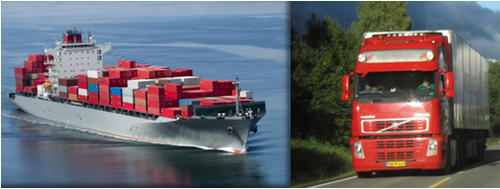
Foreign transport of goods on Norwegian roads and in Norwegian waters
Is the accident risk of foreign transporters of goods higher than that of Norwegian actors? What are the consequences for traffic safety if the Norwegian domestic market for road transport of goods is opened for actors from EU-countries in 2014? A new research project will answer these questions, examine risk factors and suggest measures.
Road transport of goods
Although the increasing share of foreign actors in road transport in Norway is well documented, little is known about the consequences for national road safety, because the accident risk of foreign lorry drivers has not been calculated. Data from the National Public Roads Administration and the police seem, however, to indicate that foreign actors are overrepresented in accidents, especially during winter. The current project will provide systematic knowledge on these issues.
Sea transport of goods
Since the 1970s the transport of goods by ship has been increasingly internationalised. The domestic transport of goods at sea in Norway is open to foreign actors, and port statistics show an increase in internationally registered ships in domestic and international traffic in Norway. The share of foreign ships involved in groundings along the coast of Norway increased dramatically from 5 % in 2000 to 34 % by 2004.
Foreign cargo ships now constitute a substantial share in the Norwegian statistics of ship accidents and groundings. The question is whether this trend reflects the higher share of foreign ships sailing in Norwegian waters (port statistics) or a real difference in accident risk for domestic and foreign ships.
Aims of the project
The main aims of the project are to assess the effect on accident risk of the increasing shares of foreign actors in road and sea transport of goods in Norway; and to provide a scientific knowledge base that Norwegian authorities can use to develop measures to reduce any increased risk identified.
Cabotage
The involvement of foreign actors in the domestic market for road transport of goods is limited by Norwegian regulations today (February 2013). These regulations are likely to be changed in 2014.
The EU currently intends to liberalize cabotage rules in all member countries, and it is likely that Norwegian rules will be adapted to those of the EU. Given the low level of wages in recent EU member countries it is likely that lifting the cabotage restrictions will dramatically increase the share of Eastern European lorries in Norway. To ensure that these lorries do not effect a disproportionate increase in accident risk on Norwegian roads, it is important to quantify their accident risk, and regulate to control it as necessary.
The project is funded by the Norwegian Research council
The project is funded by the TRANSIKK program of the Norwegian Research Council and lasts for three years (2013-2015). For more information, confer: www.forskningsradet.no/transikk






